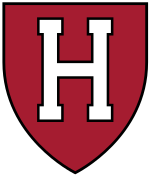Harvard football
| Harvard Crimson football | |||
|---|---|---|---|
|
|||
 |
|||
| First season | 1873 | ||
| Head coach |
Tim Murphy 23rd year, 163–66 (.712) |
||
| Stadium | Harvard Stadium | ||
| Seating capacity | 30,323 | ||
| Field surface | FieldTurf | ||
| Location | Boston, Massachusetts | ||
| Conference | Ivy League | ||
| All-time record | 829–383–50 (.677) | ||
| Bowl record | 1–0 (1.000) | ||
| Claimed nat'l titles | 7 | ||
| Conference titles | 14 | ||
| Colors | Crimson, White, and Black |
||
| Fight song | Ten Thousand Men of Harvard | ||
| Mascot | John Harvard | ||
| Outfitter | Nike | ||
| Rivals | Yale Bulldogs (rivalry) | ||
| Website | GoCrimson.com | ||
The Harvard Crimson football program represents Harvard University in college football at the NCAA Division I Football Championship Subdivision (formerly Division I-AA). Harvard's football program is one of the oldest in the world, having begun competing in the sport in 1873. The Crimson has a legacy that includes nine national championships and 20 College Football Hall of Fame inductees, including the first African-American college football player William H. Lewis, Huntington "Tack" Hardwick, Barry Wood, Percy Haughton, and Eddie Mahan. Harvard is the eighth winningest team in NCAA Division I football history.
The Harvard Crimson was one of the dominant forces in the early days of intercollegiate football, winning 9 college football national championships between 1890 and 1919. In both 1919 and 1920, headed by All-American brothers Arnold Horween and Ralph Horween (who also attended Harvard Law School), Harvard was undefeated (9–0–1, as they outscored their competition 229–19, and 8–0–1, respectively). The team won the 1920 Rose Bowl against the University of Oregon, 7–6. It was the only bowl appearance in Harvard history.
...
Wikipedia
